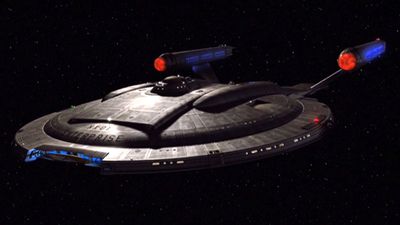Does Star Trek make space travel look too easy?by Andre Bormanis
|
| The simplicity with which a vehicle or device can be controlled says nothing about its complexity. |
Life aboard the various incarnations of the starship Enterprise was obviously not hardship duty. More cruise ship than battleship, with their expansive cabins, wide corridors (a waste of internal space necessitated by the need to accommodate TV cameras on bulky dollies), and artificial gravity, Enterprise made interstellar travel look very comfortable – if not exactly easy. Gene Roddenberry, creator of the original Star Trek and Star Trek: The Next Generation, insisted on a certain level of “realism” in the depiction of future starship technologies, and incorporated the suggestions of numerous scientists and engineers to create a fictional spaceship that had the look and feel of something that could—maybe, someday—exist. The purpose of this effort was not to predict how a starship would actually work, but to make it easier for the audience to suspend its disbelief long enough to enjoy the stories Gene wanted to tell.
I doubt it ever occurred to Gene that this might create unrealistic expectations among the general public about the future of space travel. He was a man who fervently believed that the human race could turn any dream into reality. But he had no illusions that the kind of technical progress envisioned by Star Trek would be easy. In fact, many of the stories we told on the show are about just how hard and dangerous space exploration can be.
More to the point, the simplicity with which a vehicle or device can be controlled says nothing about its complexity. When I get into my car, turn the key and hear the engine start, it doesn’t lead me to assume that building a car is easy. When I open my laptop and see the screen light up, I don’t immediately think that designing and fabricating a personal computer must be simple. The industries that produce cars and computers have worked very hard over many years to become good at what they do. We’ve now come to expect a certain level of performance from them. I can’t imagine many people believe that achieving these technological feats has been a walk in the park for the people responsible for them.
Expectations for a glorious future in space were fueled at least as much by the extraordinary accomplishments of NASA in its early years as by the visions of science fiction writers. When I was a boy, I had a piano teacher who was 21 years old when the Wright Brothers flew at Kitty Hawk. She lived to see men walk on the Moon. Charles Lindbergh, the first man to fly solo across the Atlantic Ocean—an amazing, death-defying feat in 1927—attended the launch of Apollo 11. He was just 66 years old at the time.
When people watched a space shuttle launch on TV, they typically heard a simple countdown, followed by the sight of the main engines firing, then the solid rocket motors. From a dramatic explosion of fire and smoke, the shuttle rose majestically into the sky, as if conjured by magic. In other words, it seemed about as easy as Captain Picard saying, “engage.”
| One could argue that Star Trek in particular has done a better job of extolling the societal value of space exploration than NASA has. |
NASA sold the shuttle program to Congress on the promise of making access to space routine and (relatively) inexpensive. Almost as easy as commercial airline flight, eventually. Civilians would even be able to ride the shuttle someday. NASA managers believed that its fleet of orbiters, flying as often as once a week, would bring down the cost of getting people into space by an order of magnitude or more. That was the rationale for the program. For years, NASA continued to buy its own hype about routine access to space, until the Challenger tragedy reminded everyone how difficult space travel really is.
The agency faltered in the post-Apollo era, but not through any fault of its engineers. Instead, it faltered because of the simple fact that American taxpayers, and their representatives in Congress, didn’t consider space exploration a priority, and weren’t willing to spend the money for another Apollo-level effort. One could make the case that the reluctance of NASA’s leadership to accept this fact has hindered human space exploration: by failing to recognize the reality of its budget limits, NASA over-promised and under-delivered on its two big post-Apollo programs, Shuttle and ISS. Bold new agendas for sending astronauts beyond Earth orbit without substantially increasing the NASA budget are met with understandable skepticism.
Not many people in the space community are effective at communicating to the general public how important their work is. Since funding ultimately depends on public support, it is extremely important, in these tough economic times, to promote space. Science fiction has done this for decades. One could argue that Star Trek in particular has done a better job of extolling the societal value of space exploration than NASA has.
Whatever Star Trek represents in the American imagination, it isn’t impatience with NASA. Star Trek fans are among NASA’s biggest supporters. Maybe it will never be as comfortable and safe as a cruise aboard the starship Enterprise, but the aspiration to make space accessible to anyone with the willingness to work hard enough to get there should be a primary goal for NASA—and that purpose isn’t served by using a TV show as an excuse for the failure of our spacefaring dreams to become reality.
